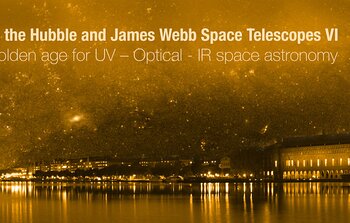December is a favourite month, not only because of the excitement of the approaching holidays and the related flurry of joyous activities with family and friends, but because it offers an opportunity to pause and take stock of the year’s accomplishments, and to look ahead at what is in store for 2020.
First, let me congratulate you all on your great success in obtaining Hubble time, cycle after cycle and year after year, well above the guaranteed level of 15 % that the NASA-ESA partnership stipulates, over the lifetime of the mission. From my own vantage point, it is wonderful to have a community of users that is so committed to and engaged with Hubble, and our goal for the future is to replicate your success with the James Webb Space Telescope.
Regarding Webb, testing on the ground continues smoothly and the telescope is on track for a launch date of March 2021. STScI is getting ready to accept your Cycle 1 proposals and many of you are being contacted to serve on the first evaluation panels. If you wish to learn more about Webb, you will find here the full calendar of Master Class Workshops that will take place all over Europe between February and April 2020. This is your opportunity to become an expert in planning JWST observations, and we encourage you to find a location convenient to you and plan on attending — you will find it very useful!
2020 will be a momentous year for Hubble as well. Hubble will celebrate 30 splendid years in orbit, a feat that seemed a distant vision only five years ago, well beyond the dreams of Hubble’s designers and builders. And what a journey it has been! The initial problem with the mirror could have destroyed the scientific essence of the mission, but it did not and we are still here to tell that story. The ingenuity and courage of many scientists and engineers across nations and continents, and the bravery of the astronauts who visited it five times in orbit made Hubble the powerful observatory it is today. The conference “Science with the Hubble and James Webb Space Telescope VI”, being planned in Stockholm on 30 March — 3 April, will celebrate this spectacular milestone, while at the same time focusing the community on thinking about how best to use Hubble and Webb together. Read here the latest on the conference, and why you should attend.
Finally, there is now an opportunity to join our team, as we are hiring two astronomers! We have two open ESA-funded positions at STScI for direct support to Hubble or JWST. We are looking for interested scientists with an established record of independent research. You can find here additional information on these positions. Submission deadline is 9 January 2020.
Do remember that we want to hear from you! Help us make the science newsletter useful and informative to you! Tell us what you want to know, tell us what you like and what we can improve. For 2020, we are planning to continue covering Hubble and JWST, and we will bring you the most up-to-date information. We would also love to include more of your science. If interested, get in touch at HubbleNewsEurope@stsci.edu.
With the best wishes for joyous holidays, and a very successful and happy 2020,
From the ESA team at STScI.

|
23 December 2019: Bethany Downer (ESA/Hubble)
2019 was another busy year for the NASA/ESA Hubble Space Telescope.
Scientists throughout Europe used Hubble data in 2019 to announce exciting new results. Of the nine ESA/Hubble science releases published this year, some memorable scientific news that garnered particular public interest included the detection of water vapour in the atmosphere of exoplanet K2-18b ...
|
| Read more |

|
23 December 2019: Sarah Kendrew (ESA)
With new telescopes come exciting new opportunities. Technological innovations and state-of-the-art instrumentation hold the promise of scientific breakthroughs, answers to long-standing questions and perhaps unexpected new problems that will stimulate new areas of research. The James Webb Space Telescope carries many such promises — its combination of a 6.5-metre primary mirror and the broad infrared wavelength coverage ...
|
| Read more |

|
23 December 2019: María Arévalo, Raúl Gutiérrez, Javier Durán, Jesús Salgado, Deborah Baines, Bruno Merín, Guido de Marchi, Paule Sonnentrucker and Antonella Nota
The Hubble Catalog of Variables (HCV) is the first full, homogeneous, catalog of variable sources found in the Hubble Source Catalog (HSC) and built out of publicly available images obtained with the WFPC2, ACS and WFC3 instruments on board the ...
|
| Read more |

|
23 December 2019: Antonella Nota (ESA/STScI) & Pierre Ferruit (ESA) — Conference co-Chairs
We announced in the last Science Newsletter a new and exciting collaboration with the Department of Astronomy of Stockholm University — the organisation of the conference: “Science with the Hubble and James Webb Space Telescopes VI: Entering a golden age for UV-Optical-IR space astronomy”, that will be held in Stockholm from ...
|
| Read more |